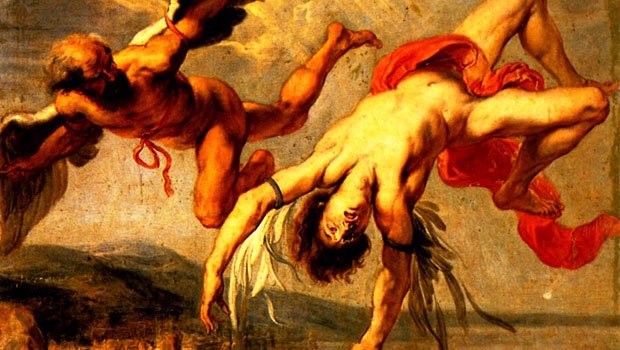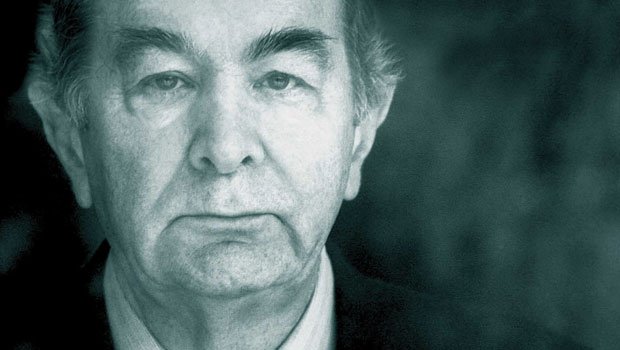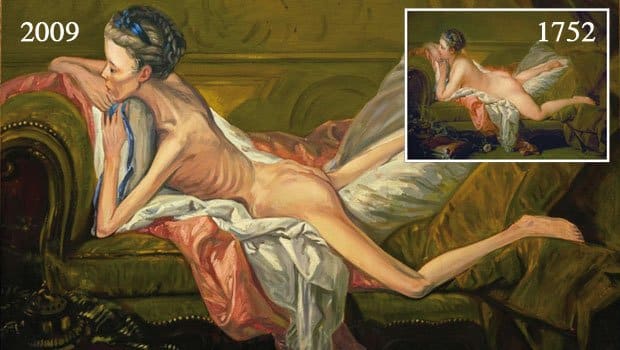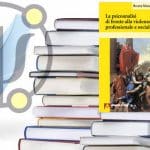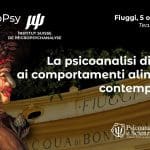Sommario
An abstract of the report expounded from the Author during the 2nd Intensive Meeting of Psychoanalysis held in Fiuggi on the 25th November 2007)
In the sentence “The sense of guilt from success” there seems to be an apparent contradiction. After all, a society in which, the social rule of a presentation is no longer “Hallo, I am Quirino Zangrilli, what is your name?” but “Hi, I’m Quirino: how much do you earn?”, does not seem to have existed before now. In a society in which the individual has disappeared, his history and his existential walk of life are no longer considered; his designer clothes, the car he drives and the watch he wears are situated in pole position in the categories of judgement of the social value; from an early age, the sense of competition is drummed into you, thus it would seem strange that the social achievement implies a continuous fight with a part of oneself that perceives the success as a blame.
I would like to specify, however, that by “success” I don’t intend to refer only to the economic and social achievements, but also to the realisation of deep desires. I would like to say that our life is a kind of Penelope’s shroud, which with hard work we weave and that despite ourselves, we incessantly unthread.
The success is a difficult objective, above all in the West: a research published in the Journal of Personality and Social Psychology by Shigeiro Oishi from the University of Virginia, (a Japanese who emigrated to the USA at the age of 23 and who was interested in finding the differences between the two populations) studied the behaviour of 350 American, Japanese and Korean students and observed that the Western people needed two positive events (a compliment or a good mark) in order to “digest” a negative one. On the contrary to their Asian colleagues to whom only one was sufficient. “It seems that the more a person in the West finds himself living positive events – Oishi observes – the more he suffers the negative ones”. It’s as if a first class traveller suffers a half hour delay by plane more than a traveller who travels in second class” he explains. 1
What interests us is the fact that success seems to put people in difficulty and forces them to a continuous feedback of expiation, which in some cases can reach self-destruction. The history is full of precious examples. Let’s look at the following phrase:
Ogn’uom di Ferruccio ha il core e la mano
I bimbi d’Italia si chiaman Balilla
Il suon d’ogni squilla
I vespri suonò
(a verse of the Italian national anthem)
Only some Italians will have recognised the written subject. But if we listen to the musical sequence of the Italian national anthem, I think that ten out of ten Italians will recognise it instantly. But who wrote the music? After all, I challenge the reader, unless he is an Opera enthusiast to list the authors of the Libretto of “The Tosca” by Puccini, “The Barber of Seville” by Gioacchino Rossini, “Cavalleria Rusticana” by Pietro Mascagni, “Don Giovanni” by Amadeus Mozart and so on…
Since the world began, it is the composer of the music who remains through history.
The composer of our national anthem is Michele Novaro who was born on the 23rd of October 1818 in Genoa, where he studied composition and singing. In 1847 he was in Turin under contract as second tenor and choral director of Regio Theatre and Carignano Theatre. A Liberal supporter, he offered his talent as a composer to the independence cause writing tens of patriotic songs and organising performances to raise money destined for the Garibaldian exploits.
Of an introverted and modest nature, he didn’t take any advantages from his most famous anthem, not even after the Italian unification. Once back in Genoa, between 1864 and 1865 he founded a Popular Choral School to which he dedicated all his time and energy. He died poor on the 21st of October 1885 and his life was marked by great financial difficulties and by health problems.
Here is the description, made by the Author himself, of the moment in which he composed the music of the anthem:
“I know that I cried, that I was agitated and I couldn’t stay still. I sat at the harpsichord with the lyrics of Goffredo on the music stand and I strummed, I killed that poor instrument with my barking fingers, with my eyes constantly on the anthem writing down melodic strains one after the other but far a thousand miles from the idea that they could be adequate for those words. I stood up unsatisfied with myself; I remained a little longer in Valerio’s house, but always with those lyrics in front of my eyes. I realised that there was no solution, I said goodbye and ran home. There, without even taking off my hat, I threw myself at the pianoforte. The motif I had strummed in Valerio’s house returned to my memory: I wrote it on a piece of paper, the first I could find: in my agitation I spilt the oil lamp over the harpsichord and, as a consequence, over the poor sheet of paper too; This was the original draft of the anthem “Fratelli d’Italia”.
The Author tells us that in the very act of its creation he almost set fire to the composition and to the instrument that had played it!
What’s more, the obvious fact that Novaro composed the music impulsively cannot escape us, but in order to do it he had to be alone: afflicted by the compulsion to failure, he could not show his capabilities even to the smallest group of friends.
How many musicians of extraordinary talent live their artistic lives in the shadows due to the impossibility of exhibiting themselves?
And what should we say about the expiation that some scientists have atoned to for having undermined the religious and scientific references of their times?

Let’s take a look at Einstein’s famous equation that we all know:
E= mc2
Let us concentrate on the only number present, the square number, nowadays a term taken for granted but not in the middle of the 1700s…
In his work of popularisation of Newton’s theories, Lavosier sustained consolidated theses: when colliding objects were analysed, in those days, the only factor taken into consideration was the product of their mass multiplied by the velocity or rather their mv1.
If a cannonball weighing 5 Kg travels at a velocity of 10 Km per hour, it has 50 units of energy.
But Gabrielle Émilie le Tonnelier de Breteuil, Marquise du Châtelet, for our convenience Mme Du Chattel, had another hypothesis, alternative to Newton’s theory, elaborated by the great philosopher Leibniz, according to whom the factor to be taken into consideration was instead:
mv2
If a cannonball weighing 5 Kg travels at a velocity of 10 Km per hour, it has 5 x 102 or rather 500 units of energy: quite a difference, don’t you think?
Which of the two theses was correct?
Nowadays, we should be capable of distinguishing science from religion but in the 1700s it was not so! If truth be known, it is not so today either but for discretion’s sake, let’s leave it be!
Newton believed that verifying the validity of mv1 would have demonstrated the existence of God!
Let’s imagine two weights of metal which collide frontally. An instant before the collision, a great quantity of mv1 was present in the universe: after the impact, when by then the two weights were reduced to a shapeless mass of metal, the two distinct components of the v1 had disappeared: they had annulled each other.
In Newton’s concept this meant that all the energy possessed by the weights before the impact had disappeared, leaving a hole somewhere outside of our visible universe. As collisions like this happen incessantly, if it is true that we live inside an enormous clock, it is just as true that such a mechanism needs to be continuously charged.
Using various geometrical abstract arguments, Leibniz had faced the question about the existence of holes of energy in the universe, hypothesised by the Newton theory.
He wrote: “According to the doctrine (of Newton), God has to wind his clock every now and then because otherwise it would stop working. It would seem that He wasn’t provident enough to impress a perpetual motion in his clock”.
It resulted that considering the energy equal to mv2, it was possible to get round this problem. Let’s imagine that the mv value of a weight which travels towards west is 100 units of energy, while the value of another weight, travelling in the opposite direction on the collision route of the first, is also 100 units.
According to Newton, during the impact the two energies should annul each other, whilst according to Leibniz, they should sum together. When the two weights collide, all their energy continues to exist and it is capable of projecting pieces of metal into the air, heating them and usually causing a deafening noise.
In this vision of Leibniz, nothing is lost. The world functions alone; there are no holes or leaks from which the energy could accidentally escape, in a way that only a God would be capable of replacing it. We are alone. By sheer hypothesis, as Bodanis acutely reminds us, we may have needed God in the beginning, but no longer subsequently.
Emile Du Châtelet and her collaborators found the decisive proof of Leibniz’s theory in Willem Jacob’s Gravesande’s experiments, a Dutch researcher who had analysed the falling of various weights onto a clay surface, putting into evidence that the formula seemed to represent, for goodness knows which strange reason, a fundamental rule in nature.
The publications of the noblewoman created a great impression. After the publication of her work, the Du Châtelet granted herself a brief holiday but when she returned to Cirey, she hastily wrote a letter to a friend:
3rd April 1749 The Castle of Cirey
I am pregnant and you can imagine… how worried I am for my health and even for my very own life… having to give birth at the age of 40.

Three days later, the birth began, from which the woman survived only to die a week later due to an infection. The Du Châtelet immediately paid for her own courage, as Icarus in his challenge against the Sun.
We can also associatively link this event to another specular event: the birth. The enormous decrease of perinatal and neonatal mortality, which modern technological medicine has reached, must not allow us to forget that for hundreds and thousands of years the birth of human beings has been a truly key-event in the survival of the mother or the unborn or for both.
Since time began, millions of women have died from birth and millions of newborn have not survived. The first success of the human being is, therefore, the birth but often it is associated to the pain, or sometimes, to the invalidity of the person who has carried and nurtured us for nine months.
A heavy weight, that cannot be removed easily, burdens the shoulders of the unfortunate, unknowing infants who have had a mother who died giving birth or whose health was gravely compromised due to the birth.
Generally, we think that the situations; of progress, of improvement, of realisations, of social expansion in a sentimental and human way, cannot constitute a matter of interest in the analytic work. But we are mistaken because, paradoxically, the final part of every psychoanalysis and the essence of small pieces of work requested by the patients who have completed (if it can be said) their analysis from a long time, are often motivated by an intense sense of emptiness which the subject feels in conjunction with an important situation of success. Targets reached, hard work completed, the heights of carriers happily reached, the crowning of exhausting courtships, desired births, it doesn’t matter which situation of small or great triumph is experienced, this often determines an intense sufferance, a cold and empty sensation.
In another work, “The Seven Deadly Sins”, published in this Review, I hypothesised that the seven sins are in reality only one, the founding Sin of the human civilisation. The Parricide from which the relative conducts of expiation and reparation derive.
But how does God react to the sins of his people? Sealing a sacred deal with his chosen people: the Jews. And here we are truly at the “casting out nines”!
The Brit Milah (literally “Covenant of Circumcision”), known in the Yiddish language as Bris (from the Hebrew Berit, “covenant”), is a religious ceremony within Judaism to welcome infant Jewish boys into a covenant between God and the Children of Israel through ritual circumcision performed by a mohel (“circumciser”) in the presence of family and friends, followed by a celebratory meal.
The interesting thing is that the Milah happens on the eighth day of the child’s life during the day: if by mistake the circumcision is made before the eighth day or during the night, it is not valid and a drop of blood must be taken after the baby has healed.
It cannot be ignored that eight is the number that follows seven!
Not everybody knows that the Milah also includes the Metzitza, that is the sucking of the blood from the wound, which in my eyes, seems to be the inverted repetition of the totemic meal: you Child have killed the Father and you have eaten him, I Father, will kill you “pars pro toto” and I will take back orally what has been subtracted from me!
Furthermore, it is notorious how the elimination of the foreskin diminishes the sexual pleasure noticeably; in the ritual act there is also an attempt to defuse the drive toward the parricide that, as I have illustrated in my article “The Seven Deadly Sins”, derives for the burning desire towards the females of the family!
With regard to this, the enormous traumatic impact of the circumcisions, performed at such a tender age in medical pathologies, such as phimosis, paraphimosis and the short frenulum, should be underlined.
In the psychoanalytic treatment of a severe case affected by a border-line pathology, it was possible to reconstruct the ego of the patient’s mind, disgregated during the nights spent on a hospital ward for adults after a frenectomy operation: the event was lived by the child as a true castration. So much so that, during a sitting, availing myself of my medical prerogative, I was obliged to ask the patient to show me his penis since he had been speaking for about one hundred hours of its absence.
Fortunately, the organ was obviously in its place: it had simply disappeared from his mind.
And here I must insist again and again on the importance of the personal experience, in other terms, on what we define as phantasmatic or the set of phantasies, blended with affect and emotions, which structure the psychic representation of the reality.
In the deep unconscious of children of either sex, the male and female do not exist: a person endowed with a phallus and a castrated person exist.
While with the vision of the opposite sex, the boy has the concrete proof that the threats of castration from the father or his substitutes are a real danger (his sister or his cousin were naughty boys whose phallus has been eliminated), a fact which determines an enormous reinforcement of the fear of castration, instead the little girl feels as though she is an unfinished human being, she accuses her mother for her handicap and begins to envy and desire to have a phallus.

The strong desire that the child has for his mother, pushes him to challenge a person who is 4 or 5 times his size and endowed with an huge phallus: these proportions will be his unit of measurement for his entire sentimental and sexual life.
The last siblings, especially if born at a distance of years from the older brothers, will conserve an inferiority vicissitude, difficult to re-dimension.
They find themselves contending the oedipus object against true cyclopses: the father and the brothers.
I do not use this term by chance: the Cyclops is the actual phallic representation, which is guarding the cave!
And in fact it is necessary to become a “Mr. Nobody” to escape their attention!
The little girl will conserve in her depth a sense of inferiority towards the male, difficult to overcome. It is for this reason that female professionals, craftswomen and female scientists who have nothing to envy their male colleagues, often have an inexplicable fear towards them and an over-evaluation of the male.
I know of female colleagues, who have an absolute professional and scientific value, but conserve an inexplicable and irrational high consideration for some mediocre colleagues.
The only solution possible for children tormented by the invincible anguish of the imminent castration is the self-castration.
The unconscious sense is: I will do it myself, so I won’t kill myself and it won’t hurt as much.
I won’t place myself in his hands.
The result is that classic self-destructive behaviour which feeds a large part of the fate neurosis, characterised by a continuous behaviour of renunciation and self-punishment.
The obtainment of success, the unconscious killing of one’s own Father, automatically implies the dissolution of the obstacle, of the rival and of the persecutor (whichever form it had taken previously) The elimination of the limits, even if it is often accompanied by a comfortable sense of freedom, enormously dilates the confines of the human being, increasing the perception of the universal Void and amplifying his anguish.
If the analysed is not able to metabolise the impact with the Unlimited, which implies the contemporaneous feeling of his complete individual worthlessness, he often puts into act attempts, sustained by the compulsion to repeat, to put into act again persecutory situations of anchorage and binding. It is obvious that, as the analysis proceeds, the game becomes ever more evident and therefore less practicable.
Written by: Quirino Zangrilli © Copyright
Translated by Linda De Nardo
(videographics: Luca Zangrilli ©)
(part 2)
Key words
Sense of guilty
Success
Castration
Abstract
The social affirmation implies a continuous fight with a part of oneself that perceives success as a blame and pushes one to put into act dangerous behaviour of punitive self-castration.
Notes:
1 Suh, E., Diener, E., Oishi, S., & Triandis, H. C. (1998). The shifting basis of life satisfaction judgments across cultures: Emotions versus norms. Journal of Personality and Social Psychology, 74, 482-493.
2 David Bodanis, E=mc2: A Biography of the World’s Most Famous Equation, Walker & Company, October 2005,
Nel 2024 riceve il Premio Accademico d’Onore della Accademia Culturale Internazionale Cartagine 2.0.
Doctor Quirino Zangrilli was born in Fiuggi in 1955. Graduated with honours in Medicine and Surgery in 1980, he practices Psychoanalysis, with intensive method, since 1982. He is author of 72 scientific pubblications. He has attended as speaker or president of session to many national and international scientific Conventions. His book “La vita:involucro vuoto” (Life: empty involucre), published by Borla in 1993, has been in use by the Chair of Dynamic Psychology at Turin’s University since 1994. He is the author and founder of the multimedia review “Psicoanalisi e Scienza” (Psychoanalysis and Science), the most read Italian on line review of psychoanalysis. In 2012 he participated as a Speaker at the Scientific Festival of BergamoScienza. In 2013 he illustrated his research on the maternal-fetal interaction in the Special Session of the XI World Congress of Perinatal Medicine in Moscow with his relation “Intrauterine Imprinting”. He is visiting teacher at Moscow Institute of psychoanalysis and training psychoanalist of Swiss Institute of Micropsychoanalysis.
In 2024 he received the Honorary Academic Award of the Carthage 2.0 International Cultural Academy
Le Le Docteur Quirino Zangrilli est né à Fiuggi en 1955. Diplômé avec mention en Médecine et Chirurgie en 1980, il pratique la psychanalyse depuis 1982, en utilisant une technique intensive. Il est l’auteur de 72 livres et publications scientifiques. Il a participé en tant que conférencier ou président de session à de nombreuses conférences scientifiques nationales et internationales. Son livre “La vie : enveloppe vide”, publié par Borla en 1993, est adopté depuis 1994 par la Chaire de Psychologie Dynamique de l’Université de Turin. En 1994, il a reçu le “Prix national Ciociaria de médecine”. Il a conçu et fondé le magazine multimédia “Psicoanalisi e Scienza”, qui est le magazine de psychanalyse en ligne en italien le plus suivi au monde. (Source : Entireweb, Alexa, Google, Virgilio, Arianna., etc.). En 2012, il a participé en tant que conférencier à la colloque scientifique de BergamoScienza. En 2013, il a exposé ses études sur l’interaction materno-fœtale lors de la session spéciale du XIe Congrès mondial de médecine périnatale à Moscou avec le rapport “Intrauterine Imprinting”. Il est chargé d’enseignement au cours de spécialisation de trois ans en psychanalyse, psychothérapie psychanalytique et consultation psychanalytique à l’Université de Moscou. Il est membre didacticien de l’Institut Suisse de Micropsychanalyse et de la Commission pour la Pratique de celui-ci.
En 2024, il reçoit le Prix Académique Honoraire de l’Académie Culturelle Internationale Carthage 2.0.
В 2024 был награжден Почетной академической премией Академии Международной Культуры «Карфаген 2.0».

